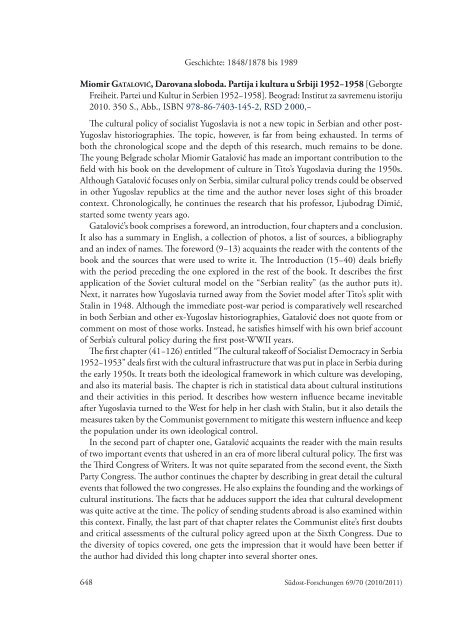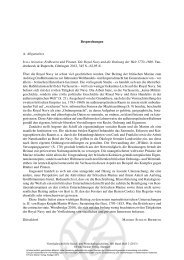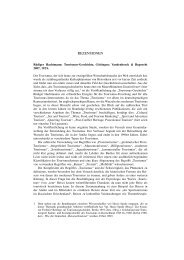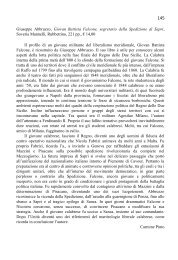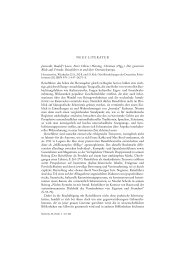69/70 (2010/2011) - Recensio.net
69/70 (2010/2011) - Recensio.net
69/70 (2010/2011) - Recensio.net
Sie wollen auch ein ePaper? Erhöhen Sie die Reichweite Ihrer Titel.
YUMPU macht aus Druck-PDFs automatisch weboptimierte ePaper, die Google liebt.
Geschichte: 1848/1878 bis 1989<br />
Miomir gatalović, Darovana sloboda. Partija i kultura u Srbiji 1952−1958 [Geborgte<br />
Freiheit. Partei und Kultur in Serbien 1952−1958]. Beograd: Institut za savremenu istoriju<br />
<strong>2010</strong>. 350 S., Abb., ISBN 978-86-7403-145-2, RSD 2 000,−<br />
The cultural policy of socialist Yugoslavia is not a new topic in Serbian and other post-<br />
Yugoslav historiographies. The topic, however, is far from being exhausted. In terms of<br />
both the chronological scope and the depth of this research, much remains to be done.<br />
The young Belgrade scholar Miomir Gatalović has made an important contribution to the<br />
field with his book on the development of culture in Tito’s Yugoslavia during the 1950s.<br />
Although Gatalović focuses only on Serbia, similar cultural policy trends could be observed<br />
in other Yugoslav republics at the time and the author never loses sight of this broader<br />
context. Chronologically, he continues the research that his professor, Ljubodrag Dimić,<br />
started some twenty years ago.<br />
Gatalović’s book comprises a foreword, an introduction, four chapters and a conclusion.<br />
It also has a summary in English, a collection of photos, a list of sources, a bibliography<br />
and an index of names. The foreword (9−13) acquaints the reader with the contents of the<br />
book and the sources that were used to write it. The Introduction (15−40) deals briefly<br />
with the period preceding the one explored in the rest of the book. It describes the first<br />
application of the Soviet cultural model on the “Serbian reality” (as the author puts it).<br />
Next, it narrates how Yugoslavia turned away from the Soviet model after Tito’s split with<br />
Stalin in 1948. Although the immediate post-war period is comparatively well researched<br />
in both Serbian and other ex-Yugoslav historiographies, Gatalović does not quote from or<br />
comment on most of those works. Instead, he satisfies himself with his own brief account<br />
of Serbia’s cultural policy during the first post-WWII years.<br />
The first chapter (41−126) entitled “The cultural takeoff of Socialist Democracy in Serbia<br />
1952−1953” deals first with the cultural infrastructure that was put in place in Serbia during<br />
the early 1950s. It treats both the ideological framework in which culture was developing,<br />
and also its material basis. The chapter is rich in statistical data about cultural institutions<br />
and their activities in this period. It describes how western influence became inevitable<br />
after Yugoslavia turned to the West for help in her clash with Stalin, but it also details the<br />
measures taken by the Communist government to mitigate this western influence and keep<br />
the population under its own ideological control.<br />
In the second part of chapter one, Gatalović acquaints the reader with the main results<br />
of two important events that ushered in an era of more liberal cultural policy. The first was<br />
the Third Congress of Writers. It was not quite separated from the second event, the Sixth<br />
Party Congress. The author continues the chapter by describing in great detail the cultural<br />
events that followed the two congresses. He also explains the founding and the workings of<br />
cultural institutions. The facts that he adduces support the idea that cultural development<br />
was quite active at the time. The policy of sending students abroad is also examined within<br />
this context. Finally, the last part of that chapter relates the Communist elite’s first doubts<br />
and critical assessments of the cultural policy agreed upon at the Sixth Congress. Due to<br />
the diversity of topics covered, one gets the impression that it would have been better if<br />
the author had divided this long chapter into several shorter ones.<br />
648 Südost-Forschungen <strong>69</strong>/<strong>70</strong> (<strong>2010</strong>/<strong>2011</strong>)


